A
Auto Express
Guest
Verdict
The Citroen C5 Aircross builds on the refinement offered by petrol and diesel versions with a smooth powertrain, but it also shares the same lifeless steering and peculiar ride. It’s still close to matching the appeal of its sister model, the Peugeot 3008, for a lower price. But for private buyers, this plug-in hybrid C5 Aircross is still a lofty proposition.
This is the new plug-in hybrid version of the Citroen C5 Aircross, and it marks an important milestone for parent company PSA.
That’s because it means that all four of the company’s brands - Citroen, DS, Peugeot and Vauxhall - now offer a plug-in hybrid family SUV. All four use the same platform called EMP2, and all use the same powertrain: a 1.6-litre turbocharged petrol engine mated to a battery and electric motor system.
As such, it’s best to differentiate them on the subtleties of their branding. In the case of the Citroen, that means we’re looking for striking looks, the promise of a comfortable driving experience, and good value for money.
If you get Citroen’s latest design language the C5 Aircross will sell itself and, like those other PSA plug-ins, the Hybrid-specific design tweaks are subtle, amounting to blue badges on the front wings and blue Airbump rims.
What will be of interest to more private buyers is the price. The entry-level C5 Aircross undercuts the cheapest 3008 by around £1,200 and the DS 7 Crossback by a massive £12,355. That last figure is explained mainly by the DS 7 only coming with a 296bhp dual electric motor version of PSA’s plug-in hybrid powertrain: an option too expensive for Citroen buyers, according to the firm’s bosses.
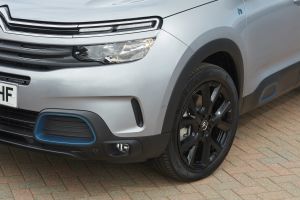
image
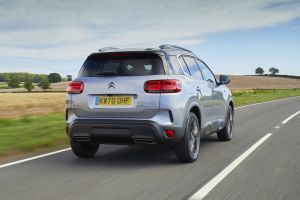
image
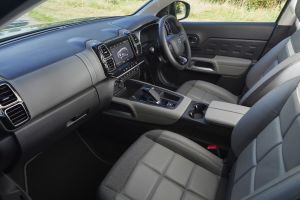
image
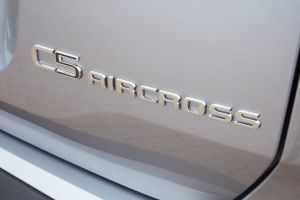
image
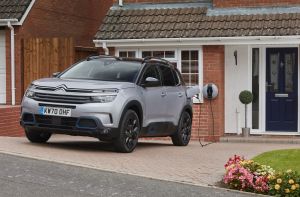
image
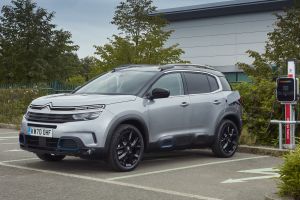
image
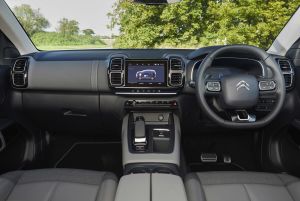
image

image
The C5 Aircross makes do with a 178bhp output, which is perfectly adequate for most buyers. The resulting 8.7 second 0-62mph time is reasonable; any more than this would likely ask too many questions of the C5 Aircross’s chassis.
The ride is strangely inconsistent despite a rear suspension setup tuned specifically for the Citroen. It’s floaty at high speed, but gets caught out by sharper bumps at round-town pace. The steering is light at low speeds, and doesn't really weight up as your speed increases.
Refinement is excellent, however. Not just good for a plug-in hybrid, but good full-stop. At low speeds and relying on electric power only, the double-glazed windows and soundproofing do an outstanding job of isolating wind and road noise, and even when the four-cylinder engine kicks in, it does so almost imperceptibly. The eight speed auto does a fine job of shuffling up the gears, though can get caught out by sudden prods of the throttle.

image

image

image

image

image

image

image

image
Three drive modes are available, Electric, Hybrid and Sport. A fourth option, accessed by a separate button allows you to hold the battery charge, so it can be used when you enter an urban area. You can also use this setting to charge the battery on the move with the petrol engine though like all PHEVs, it’s an inefficient way to drive.
It takes two hours to charge the 13.2kWh battery from a 7kW wallbox, which is good for a claimed, and realistic, 34 miles of all-electric driving. As a result, fuel economy sits at 157.2-222.3mpg under WLTP testing, though with a flat battery you can expect a figure closer to 43mpg. Assuming you charge it regularly, official CO2 emissions are rated between 32 and 41g/km, so the C5 Aircross Hybrid sits in the 10 per cent company car tax bracket in the 2020/21 financial year.
Inside, there’s little to tell the Hybrid apart from other models. There’s a blue LED behind the rear-view mirror to tell other road users when the car is running in electric mode, and a button which allows access to the various hybrid-specific menus in the infotainment system. Elsewhere, it’s business as usual, meaning there’s decent space for five to sit in the extremely comfy seats, and despite a reduction in size over petrol and diesel models, the 460 litre boot is decent and has underfloor cable storage.
There are three ergonomic oddities though. Like other PSA products, half the glovebox is lost to a fusebox. More annoyingly, the gearstick is located on the far side of the transmission tunnel, meaning you need to stretch a fair way to select the car’s increased brake regen mode - perhaps hangovers from the left to right-hand-drive conversion,
Citroen offers the C5 Aircross Hybrid in just two trims: Flair and Flair Plus. The £35,370 Flair offers 18-inch alloy wheels, front and rear park sensors and a rear camera, an eight-inch touchscreen, Android Auto and Apple Carplay and fully-digital instruments. For another £1,470, Flair Plus adds adaptive cruise control, hands-free tailgate and electric adjustment for the driver’s seat.
Continue reading...
The Citroen C5 Aircross builds on the refinement offered by petrol and diesel versions with a smooth powertrain, but it also shares the same lifeless steering and peculiar ride. It’s still close to matching the appeal of its sister model, the Peugeot 3008, for a lower price. But for private buyers, this plug-in hybrid C5 Aircross is still a lofty proposition.
This is the new plug-in hybrid version of the Citroen C5 Aircross, and it marks an important milestone for parent company PSA.
That’s because it means that all four of the company’s brands - Citroen, DS, Peugeot and Vauxhall - now offer a plug-in hybrid family SUV. All four use the same platform called EMP2, and all use the same powertrain: a 1.6-litre turbocharged petrol engine mated to a battery and electric motor system.
- SEE MORE Best hybrid SUVs 2020
As such, it’s best to differentiate them on the subtleties of their branding. In the case of the Citroen, that means we’re looking for striking looks, the promise of a comfortable driving experience, and good value for money.
If you get Citroen’s latest design language the C5 Aircross will sell itself and, like those other PSA plug-ins, the Hybrid-specific design tweaks are subtle, amounting to blue badges on the front wings and blue Airbump rims.
What will be of interest to more private buyers is the price. The entry-level C5 Aircross undercuts the cheapest 3008 by around £1,200 and the DS 7 Crossback by a massive £12,355. That last figure is explained mainly by the DS 7 only coming with a 296bhp dual electric motor version of PSA’s plug-in hybrid powertrain: an option too expensive for Citroen buyers, according to the firm’s bosses.

image

image

image

image

image

image

image

image
The C5 Aircross makes do with a 178bhp output, which is perfectly adequate for most buyers. The resulting 8.7 second 0-62mph time is reasonable; any more than this would likely ask too many questions of the C5 Aircross’s chassis.
The ride is strangely inconsistent despite a rear suspension setup tuned specifically for the Citroen. It’s floaty at high speed, but gets caught out by sharper bumps at round-town pace. The steering is light at low speeds, and doesn't really weight up as your speed increases.
Refinement is excellent, however. Not just good for a plug-in hybrid, but good full-stop. At low speeds and relying on electric power only, the double-glazed windows and soundproofing do an outstanding job of isolating wind and road noise, and even when the four-cylinder engine kicks in, it does so almost imperceptibly. The eight speed auto does a fine job of shuffling up the gears, though can get caught out by sudden prods of the throttle.

image

image

image

image

image

image

image

image
Three drive modes are available, Electric, Hybrid and Sport. A fourth option, accessed by a separate button allows you to hold the battery charge, so it can be used when you enter an urban area. You can also use this setting to charge the battery on the move with the petrol engine though like all PHEVs, it’s an inefficient way to drive.
It takes two hours to charge the 13.2kWh battery from a 7kW wallbox, which is good for a claimed, and realistic, 34 miles of all-electric driving. As a result, fuel economy sits at 157.2-222.3mpg under WLTP testing, though with a flat battery you can expect a figure closer to 43mpg. Assuming you charge it regularly, official CO2 emissions are rated between 32 and 41g/km, so the C5 Aircross Hybrid sits in the 10 per cent company car tax bracket in the 2020/21 financial year.
Inside, there’s little to tell the Hybrid apart from other models. There’s a blue LED behind the rear-view mirror to tell other road users when the car is running in electric mode, and a button which allows access to the various hybrid-specific menus in the infotainment system. Elsewhere, it’s business as usual, meaning there’s decent space for five to sit in the extremely comfy seats, and despite a reduction in size over petrol and diesel models, the 460 litre boot is decent and has underfloor cable storage.
There are three ergonomic oddities though. Like other PSA products, half the glovebox is lost to a fusebox. More annoyingly, the gearstick is located on the far side of the transmission tunnel, meaning you need to stretch a fair way to select the car’s increased brake regen mode - perhaps hangovers from the left to right-hand-drive conversion,
Citroen offers the C5 Aircross Hybrid in just two trims: Flair and Flair Plus. The £35,370 Flair offers 18-inch alloy wheels, front and rear park sensors and a rear camera, an eight-inch touchscreen, Android Auto and Apple Carplay and fully-digital instruments. For another £1,470, Flair Plus adds adaptive cruise control, hands-free tailgate and electric adjustment for the driver’s seat.
| Model: | Citroen C5 Aircross SUV Flair Plug-in Hybrid |
| Price: | £35,370 |
| Engine: | 1.6-litre 4cyl petrol electric |
| Power/torque: | 178bhp/250Nm |
| Transmission: | Eight-speed automatic, front-wheel drive |
| 0-62mph; | 8.7 seconds |
| Top speed: | 140mph |
| Economy: | 157.2mpg |
| CO2: | CO2: 41g/km |
| On sale: | Now |
Continue reading...
